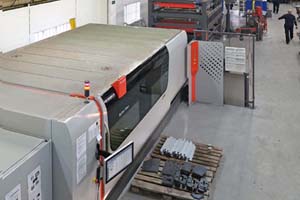10 April 2018
Fabricator reports flood of new work and invests in Bystronic
 Established in 1967, Stevens & Carlotti produces metal fabrications in its Kent factory for customers in the UK and continental Europe. A jump in turnover of 25% in 2017 compared with the previous year looks set to be followed by a further 50% increase in 2018, which has unsurprisingly caused some production and logistical issues. The situation has resulted in an increase in headcount from 70 to 100 staff in the last 18 months as well as a £1.5 million investment in new machinery since September 2017.
Established in 1967, Stevens & Carlotti produces metal fabrications in its Kent factory for customers in the UK and continental Europe. A jump in turnover of 25% in 2017 compared with the previous year looks set to be followed by a further 50% increase in 2018, which has unsurprisingly caused some production and logistical issues. The situation has resulted in an increase in headcount from 70 to 100 staff in the last 18 months as well as a £1.5 million investment in new machinery since September 2017.
Part of this sum was allocated for the purchase of a Bystronic fibre laser cutting machine of 3 m by 1.5 m sheet capacity, together with two press brakes. The three machines are installed in one unit, forming a lean production cell for processing mild steel and aluminium from 1 mm to 25 mm thick and stainless steel up to 15 mm.
Managing director Marco Carlotti commented, "Orders have flooded in recently across the board for batch sizes ranging from one-off to several thousand. They are being placed by existing and new customers, from Powergen and pumps to street furniture and road sweepers to electronics, filtration and building. Our success is partly because we offer a complete subcontract solution including cutting, bending, machining, welding, assembly and painting.
"Several cutting methods are in use here, each of which has specific advantages that give our customers best value for money. Laser cutting is the lead technology, however, and we have been using CO2-powered equipment for nearly 20 years. Due to the current higher level of business, we decided to replace one of our two second-generation 4 kW CO2 machines with a Bystronic ByStar Fiber 3015 fitted with a 6 kW power source and a ByTrans Extended automated sheet loading and unloading system.
"The benefits have been astounding. On thinner sheets, say around 5 mm, the machine is four to five times faster, accuracy of cut is better and it is possible to produce finer detail than on a CO2 machine. Fibre laser cutting is also not so expensive to run, as it consumes less electricity, does not need any laser assist gases and maintenance costs are lower."
Mr Carlotti concluded, "We have been impressed with the performance of the ByStar Fiber. The only problem we have is that it is so fast it can be difficult at times to feed the machine with the next sheet quickly enough. We are going through a major reorganisation of our site at present. As part of that, we will be rearranging the cantilever racking holding material for supply to the ByStar Fiber and will also be redesigning the breakout area to speed parts removal.”
- Contact Information
- Name: David Larcombe
- Email: david.larcombe@bystronic.com
- Website: www.bystronic.com

